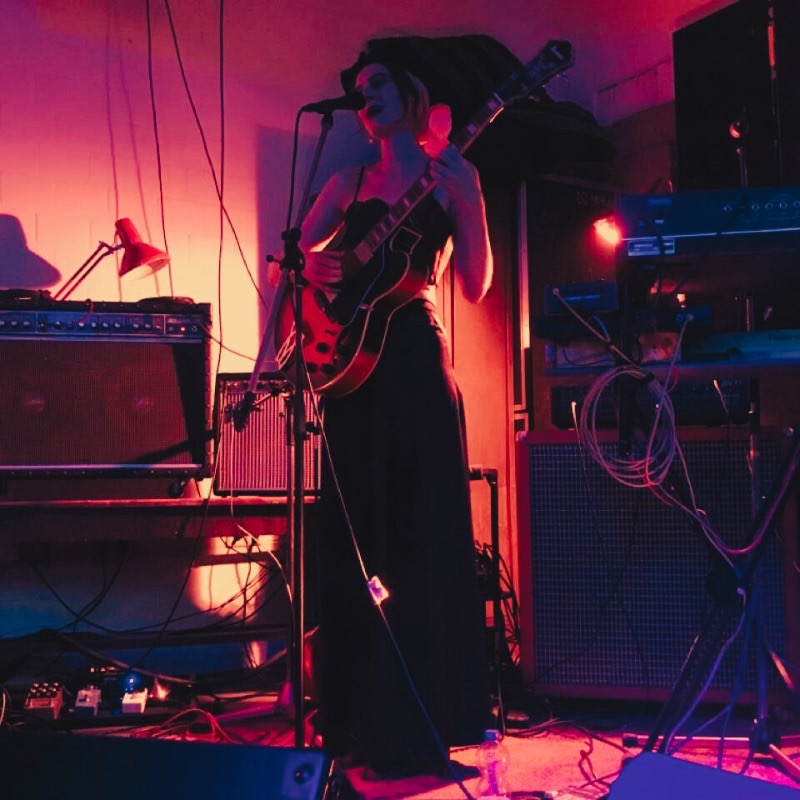Eva Nolia Vae, an up-and-coming artist hailing from Berlin, Germany, is swiftly establishing herself as a solo artist with a unique sound that is influenced by a variety of music styles. Drawing on influences from jazz, psychedelic rock, soul, and indie music, Eva offers a unique and emotionally resonant style to her artistry. She expertly combines her guitar and bass skills with a powerful, engaging singing technique as a multi-instrumentalist. Eva, who has performed at well-known locations such as Donau 115, a top jazz club in Berlin, is accustomed to playing in front of a critical audience. Starting at 24, she embarked on a musical journey filled with self-discovery, dedication, and triumph over personal obstacles. Now, after six years, she is ready to launch her first EP ‘Empty Hands’, with her song “Sweet Exhaustion” standing out as a highlight.
Eva Nolia Vae’s track “Sweet Exhaustion,” dropped on September 25th, 2024, delves deep into the concept of giving in emotionally, within the context of her diverse musical inspirations. From the initial seconds of the song, it is evident that Eva is not just making music, but curating a personal and intimate experience. The tune begins with a melody infused with jazz, creating a calm and thoughtful atmosphere. This opening appears unpolished, resembling a personal admission, with Eva’s tone displaying an unpolished, near delicate essence. It’s like she’s welcoming the listener into her feelings, creating a vibe that resembles a live, late-night show in a dimly lit room rather than a polished studio recording. This deliberate rawness in her voice is an artistic decision that quickly immerses the listener in the intricate emotional terrain that “Sweet Exhaustion” explores.
What makes “Sweet Exhaustion” stand out is its thematic richness. The song is, at its core, about finding freedom in exhaustion—a sentiment that resonates on both a personal and universal level. Eva presents exhaustion not as a mere state of physical or emotional depletion but as a gateway to surrender. The lyrical content delves into the idea that in moments of extreme weariness, whether from personal struggles or relationships, we often discover a strange sense of release. Eva’s lyrics suggest that sometimes, we defend our own misery, holding onto it as a protective shield. The track portrays exhaustion as not just an end state, but a transition into something deeper, perhaps even a form of acceptance. This philosophical take on such a familiar emotion is what gives the song its depth and invites multiple listens to unpack its layers.
As the song progresses, it shifts from its minimalist, jazz-inspired opening into a more structured indie pop arrangement. The introduction of drums, played by Berlin-based session musician Clinton Agu, provides a steady yet understated beat that drives the song forward without overwhelming its delicate atmosphere. The transition feels natural, with the rhythm picking up just enough to add momentum without losing the intimacy established in the opening. Agu’s drumming is understated yet impactful, providing a strong foundation for the song while keeping Eva’s vocals and guitar at the forefront. The equilibrium of rhythm and melody is essential for the song’s overall vibe, creating a feeling of advancement while also preserving its emotional depth.

Eva’s singing in “Sweet Exhaustion” stands out as one of the track’s most impressive features. Her voice, at times soft and vulnerable, gradually builds in intensity as the song evolves. There’s a noticeable shift from her initial restrained delivery to a more impassioned tone as the song delves deeper. The emotional journey that the song captures is reflected in the dynamic vocal range, transitioning from quiet reflection to a cathartic release. Eva’s skill in expressing a variety of emotions through her voice showcases her versatility as a performer, and it is her vocal delivery that really brings out the lyrical themes of the song.
The layering of instruments in “Sweet Exhaustion” is skillfully done, with each one bringing a distinct texture to the music without taking over the overall composition. Eva’s electric guitar and bass lay the groundwork for the song, with the vibrant jazz and neo-soul scene in Neukölln adding depth to the track. The remarkable aspect of “Sweet Exhaustion” is how it goes against traditional genre limits. Although the track is based in indie pop, it seamlessly integrates jazz, soul, and rock influences, resulting in a sound that is both recognizable and distinctly original. Eva’s diverse musical influences are reflected in the seamless blending of these genres, showcasing her unique sound.
Collaborating with London-based producer Sam Hatchwell, the track’s production is polished yet restrained, prioritizing the emotional depth of the song. The recording done at Berlin’s 1210 Studios, a location used by a tight-knit group of musicians, enhances the feeling of closeness present in the track. The production decisions improve the natural, unedited feel of the music, especially in the beginning when Eva’s vocals take the spotlight without any added effects. While the song progresses, the production gradually grows, incorporating various instruments to enhance the overall sound experience. Still, even during its most elaborate sections, the performance stays committed to preserving the emotional essence of the song, ensuring that the music does not detract from the meaning.

Ultimately, “Sweet Exhaustion” is a track that stays with you even after the music has ended. This intricate piece highlights Eva Nolia Vae’s skills as a musician and storyteller, conveying deep emotions. The song delves into fatigue, examining it as both a physical and emotional condition, providing a new outlook on a common feeling. By combining compelling singing, complex music arrangements, and thoughtful lyrics, Eva has crafted a song that is both musically entrancing and emotionally touching. “Sweet Exhaustion” is more than just a song—it’s an invitation to sit with your weariness, to find beauty in the surrender, and to embrace the freedom that comes from letting go.
For more information about Eva Nolia Vae, click on the icons below.

